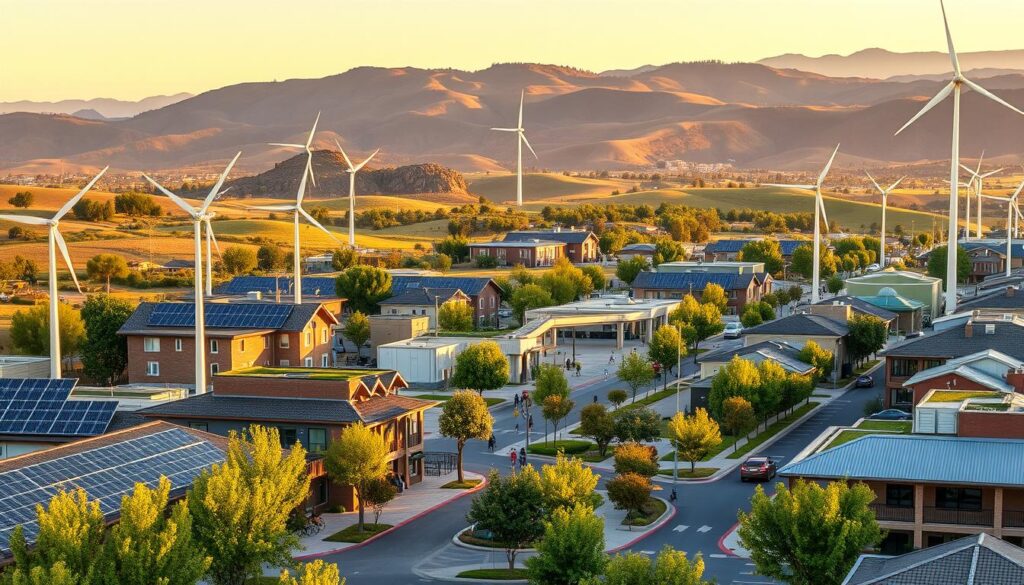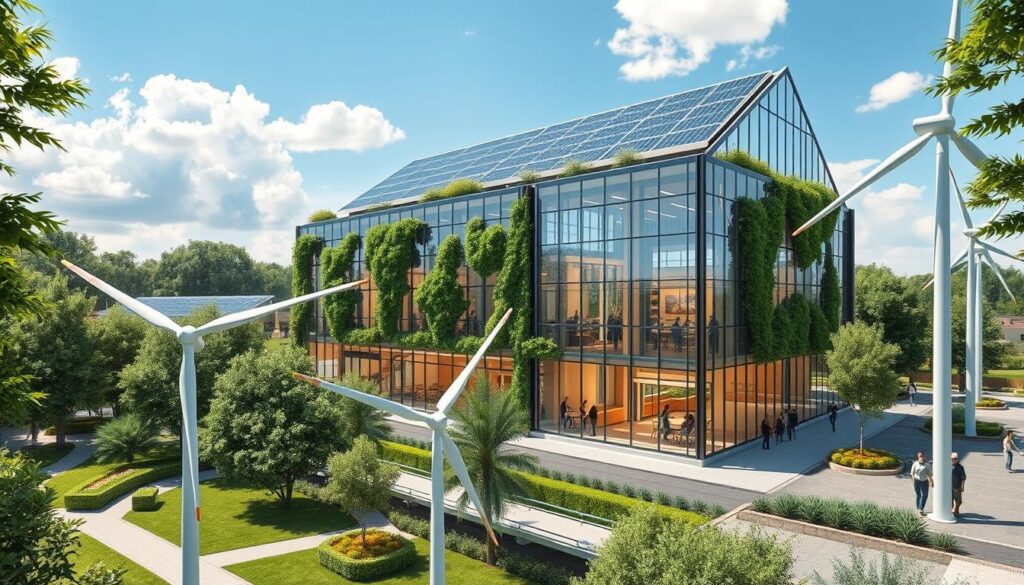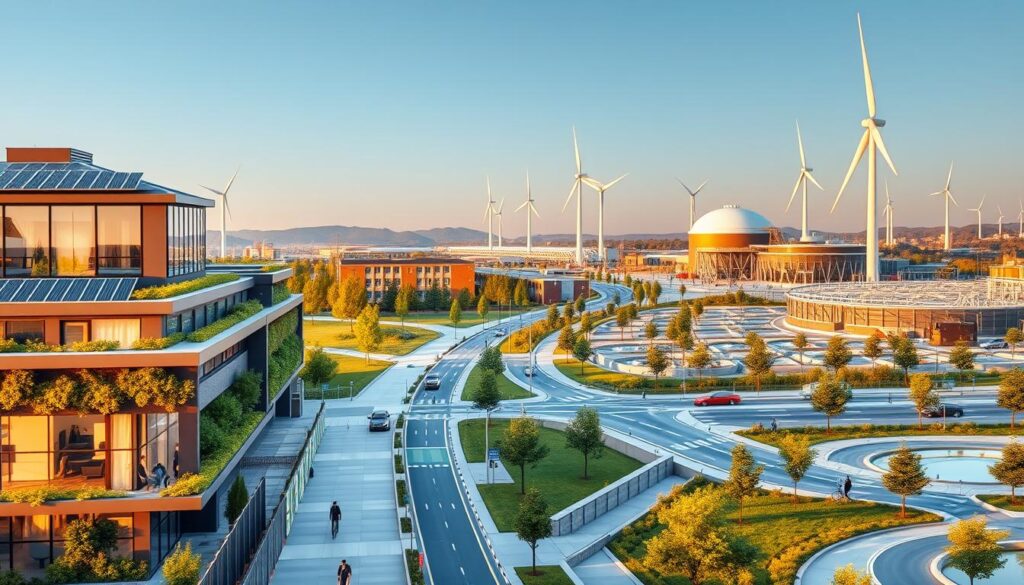The construction and building sector accounts for nearly 40% of global energy-related CO2 emissions, making it one of the largest contributors to environmental pollution. As the world grapples with the challenges of climate change, embracing sustainable practices in civil engineering has become a necessity.
Sustainable design in civil engineering plays a crucial role in reducing the environmental footprint of infrastructure projects. By incorporating green technologies and eco-friendly materials, civil engineers can create communities that are not only environmentally sustainable but also resilient and thriving.
Key Takeaways
- The construction sector is a significant contributor to global CO2 emissions.
- Sustainable practices in civil engineering are crucial for reducing environmental impact.
- Eco-friendly designs can lead to more resilient and sustainable communities.
- Innovative green technologies are being integrated into infrastructure projects.
- Sustainable community transformation is key to addressing climate change.
Introduction to Civil Engineering and Community Transformation
Civil engineers are at the forefront of community transformation, using their expertise to design and build infrastructure that is both functional and sustainable. This transformation is not just about constructing buildings and roads; it’s about creating vibrant, resilient communities that enhance the quality of life for their residents.
Definition of Civil Engineering
Civil engineering is a professional engineering discipline that deals with the design, construction, and maintenance of the physical and naturally built environment, including works like roads, bridges, canals, and buildings. It is one of the oldest and broadest engineering disciplines, playing a crucial role in shaping our modern world.
Importance of Community Transformation
Community transformation is vital for creating thriving, sustainable communities. It involves not just physical changes to the built environment but also social and economic improvements. By transforming communities, civil engineers can help address issues like congestion, pollution, and lack of green spaces, ultimately enhancing the quality of life for residents.
The impact of civil engineering on communities is profound. Well-designed infrastructure can stimulate economic growth, improve public health, and provide safe, accessible public spaces. For instance, the development of green infrastructure, such as parks and green roofs, can mitigate the urban heat island effect and improve air quality.
Role of Sustainability in Design
Sustainability is a key consideration in modern civil engineering. It involves designing infrastructure that minimizes environmental impact, conserves resources, and is resilient to future challenges like climate change. Sustainable design in civil engineering can include using recycled materials, optimizing energy efficiency, and incorporating green technologies.
| Aspect | Traditional Design | Sustainable Design |
|---|---|---|
| Materials | Conventional materials with high environmental impact | Recycled, locally sourced, and sustainable materials |
| Energy Efficiency | Limited focus on energy efficiency | Optimized for energy efficiency and renewable energy integration |
| Environmental Impact | Often results in significant environmental degradation | Designed to minimize environmental footprint and enhance biodiversity |
By embracing sustainable design principles, civil engineers can play a pivotal role in community transformation, creating infrastructure that not only supports economic and social needs but also protects the environment for future generations.
The Principles of Sustainable Design in Engineering

Civil engineering plays a pivotal role in sustainable community development through innovative design principles. As communities evolve, the need for infrastructure that supports both current and future generations becomes increasingly important. Sustainable design in engineering is not just about minimizing environmental impact; it’s about creating thriving communities.
Understanding Sustainable Practices
Sustainable practices in civil engineering involve a holistic approach to design and construction. This includes using materials and techniques that reduce environmental footprint, such as recycled materials and energy-efficient systems. Building Information Modeling (BIM) is a technology that allows for better planning, design, and collaboration on projects, helping to optimize material usage and reduce waste.
The adoption of sustainable practices is driven by the need to transform communities through civil engineering in a way that is environmentally, socially, and economically viable. This involves not just the construction of new infrastructure but also the renovation and retrofitting of existing structures to meet modern sustainability standards.
Core Elements of Sustainable Design
The core elements of sustainable design in engineering include energy efficiency, water conservation, and the use of sustainable materials. These elements are crucial for sustainable infrastructure for community development, as they help reduce the long-term environmental impact of infrastructure projects.
- Energy-efficient systems that reduce reliance on non-renewable energy sources.
- Water conservation techniques that minimize waste and optimize usage.
- Sustainable materials that are recycled, recyclable, or sourced locally to reduce carbon footprint.
The Impact of Technology on Sustainability
Technology plays a crucial role in advancing sustainable design in engineering. Innovations such as BIM, as mentioned earlier, are revolutionizing the field by enabling more precise planning and execution of projects. Other technologies, such as green building materials and smart city infrastructure, are also contributing to more sustainable community development.
The integration of technology in sustainable design not only enhances the efficiency and effectiveness of infrastructure projects but also opens up new possibilities for transforming communities through civil engineering. By leveraging these technologies, engineers can create infrastructure that is not only sustainable but also resilient and adaptable to future challenges.
How Civil Engineering Addresses Urban Challenges
As urbanization continues to reshape our world, civil engineering plays a crucial role in addressing the challenges that come with it. The environmental footprint of construction projects has been significant, from high energy consumption to the large-scale extraction of raw materials. However, with global urbanization on the rise, the time to shift toward sustainability in civil engineering is now.
Infrastructure Development
Infrastructure development is a critical aspect of civil engineering that directly impacts the livability and sustainability of urban areas. Sustainable infrastructure not only supports economic growth but also enhances the quality of life for residents. By incorporating green building practices and materials, civil engineers can significantly reduce the environmental impact of new developments.
“Sustainable infrastructure is not just a necessity for the environment; it’s also a sound economic strategy,” says an expert in the field. This approach is gaining traction worldwide as cities look to balance growth with environmental stewardship.
Transportation Systems
Efficient transportation systems are the backbone of any thriving urban area. Civil engineers are tasked with designing and implementing transportation networks that are not only effective but also sustainable. This includes developing public transit systems, pedestrian-friendly paths, and bike lanes to reduce reliance on fossil fuels.
- Public transportation systems that reduce congestion and pollution
- Pedestrian and cyclist infrastructure to promote healthier lifestyles
- Smart traffic management systems to minimize travel times
Water and Waste Management
Effective water and waste management are crucial for maintaining healthy urban environments. Civil engineers design systems that manage water resources sustainably, including wastewater treatment facilities and rainwater harvesting systems. These efforts help conserve water, reduce pollution, and protect public health.
By adopting innovative solutions such as green roofs and permeable pavements, cities can better manage stormwater runoff and reduce the burden on traditional drainage systems. This not only mitigates flood risks but also replenishes groundwater supplies.
In conclusion, civil engineering plays a vital role in addressing urban challenges through sustainable infrastructure development, efficient transportation systems, and effective water and waste management. As cities continue to grow, the importance of sustainable civil engineering practices will only continue to grow.
The Role of Green Infrastructure in Communities

As urbanization continues to rise, the importance of green infrastructure in creating sustainable and resilient communities cannot be overstated. Green infrastructure refers to the use of natural or semi-natural systems to manage urban challenges such as stormwater runoff, air quality, and biodiversity loss.
Benefits of Green Spaces
Green spaces, including parks, gardens, and green roofs, provide numerous benefits to urban communities. They enhance aesthetic appeal, improve air quality, and offer habitats for urban wildlife. Moreover, green spaces contribute to the mental and physical well-being of residents by providing areas for recreation and relaxation.
According to a study published in WJARR-2024-3415.pdf, incorporating green spaces into urban planning can significantly reduce the urban heat island effect and improve biodiversity.
Rain Gardens and Stormwater Management
Rain gardens are a form of green infrastructure designed to capture and filter stormwater runoff. By reducing the amount of runoff that enters drainage systems, rain gardens help mitigate urban flooding and improve water quality. They also provide habitats for various plant and animal species.
The implementation of rain gardens is a practical example of sustainable infrastructure for community development, demonstrating how civil engineering can contribute to community sustainability.
Urban Forestry and Biodiversity
Urban forestry involves the management of trees in urban environments to enhance their ecological, economic, and social benefits. Trees help improve air quality, reduce noise pollution, and provide shade, which can lower energy costs. Urban forestry initiatives also play a crucial role in maintaining biodiversity by preserving and expanding tree cover in cities.
By integrating green infrastructure into urban planning, communities can be transformed through civil engineering practices that prioritize sustainability and environmental stewardship.
Case Studies of Successful Community Transformations
Civil engineering plays a crucial role in transforming communities through sustainable infrastructure development. By integrating innovative designs and sustainable practices, cities can be revitalized, enhancing the quality of life for their residents.
The High Line in New York City
The High Line is a prime example of transforming underutilized infrastructure into vibrant public spaces. This elevated park built on a historic freight rail line has not only spurred economic development but also promoted community engagement and sustainable development. The project’s success has demonstrated how civil engineering can contribute to community transformation through creative reuse of existing infrastructure.
The Atlanta BeltLine Project
The Atlanta BeltLine is another significant example of community transformation. This multi-use trail and park system is being developed on a 22-mile railroad corridor surrounding the city’s central business districts. The project aims to improve connectivity, promote public health, and stimulate economic growth, showcasing the impact of sustainable design in civil engineering on urban renewal.
Philadelphia’s Green City, Clean Waters
Philadelphia’s Green City, Clean Waters program represents a comprehensive approach to managing stormwater runoff through green infrastructure. By implementing rain gardens, green roofs, and permeable pavements, the city is reducing combined sewer overflows and improving water quality. This initiative highlights the role of civil engineering for community transformation in addressing environmental challenges.
These case studies illustrate the potential of sustainable infrastructure projects to transform communities. By adopting innovative and sustainable practices, cities can address various urban challenges, from environmental issues to social and economic needs, ultimately enhancing the livability and resilience of their communities.
The Importance of Community Engagement in Design

Transforming communities through civil engineering requires more than just technical expertise; it demands active community engagement. The success of sustainable infrastructure projects hinges on the involvement of local stakeholders, ensuring that the solutions implemented are tailored to the community’s specific needs and aspirations.
Effective community engagement is a multifaceted process that involves collaborative planning, where engineers, policymakers, and community members work together to identify challenges and develop solutions. This collaborative approach not only fosters a sense of ownership among community members but also ensures that the projects are socially, economically, and environmentally sustainable.
Collaborative Planning Processes
Collaborative planning is at the heart of community engagement. It involves creating platforms where diverse stakeholders can share their insights and perspectives. According to a study published in IOP Science, collaborative planning processes are crucial for the successful implementation of sustainable infrastructure projects.
By engaging with the community, civil engineers can gather valuable local knowledge that might not be available through traditional research methods. This local knowledge is instrumental in designing infrastructure that is resilient, adaptable, and meets the community’s needs.
Inclusivity in Engineering Projects
Inclusivity is another critical aspect of community engagement. It ensures that all segments of the community, particularly the most vulnerable, have a voice in the planning process. Inclusive engineering projects are those that consider the needs of all users, regardless of age, ability, or socioeconomic status.
By prioritizing inclusivity, civil engineers can create infrastructure that promotes social equity and supports the well-being of the entire community. This approach not only enhances the quality of life for community members but also contributes to the long-term sustainability of the projects.
Gathering Local Knowledge and Insights
Gathering local knowledge is a key benefit of community engagement. Local residents possess unique insights into the community’s history, challenges, and opportunities. By tapping into this knowledge, civil engineers can develop more effective and sustainable solutions.
The process of gathering local knowledge involves various methods, including public meetings, surveys, and participatory planning workshops. These activities help to build trust between the community and the engineering teams, ensuring that the projects are aligned with the community’s vision for sustainable development.
Environmental Impact Assessments in Engineering
The integration of Environmental Impact Assessments (EIAs) in engineering projects is crucial for promoting sustainable development in civil engineering. EIAs are comprehensive studies that identify potential environmental impacts of a project and devise strategies to mitigate them, ensuring that civil engineering projects contribute positively to the environment and communities.
Understanding EIA Processes
The EIA process involves several key steps, including screening, scoping, impact assessment, and mitigation planning. It begins with screening to determine if an EIA is required, followed by scoping to identify the key issues to be addressed. The impact assessment phase involves analyzing the potential environmental, social, and economic impacts of the project.
- Identifying potential environmental impacts
- Devising strategies to mitigate adverse effects
- Ensuring compliance with environmental regulations
For more detailed information on managing civil engineering projects, including the integration of EIAs, you can refer to resources such as managing civil engineering projects.
How EIAs Shape Sustainable Designs
EIAs significantly influence sustainable design in civil engineering by highlighting areas where projects can be made more environmentally friendly. Through EIAs, engineers can adopt more sustainable materials, optimize energy use, and implement waste reduction strategies. This not only reduces the environmental footprint of the project but also enhances its sustainability and community acceptance.
- Adopting sustainable materials and practices
- Optimizing energy use and reducing waste
- Enhancing community engagement and acceptance
For insights into reducing construction’s environmental impacts, visit reducing construction environmental impacts.
Community Benefits from EIAs
The community benefits from EIAs through improved environmental quality, enhanced public health, and increased transparency in project planning. EIAs ensure that the concerns and needs of the local community are considered, leading to more inclusive and sustainable urban planning. This, in turn, contributes to the overall impact of civil engineering on communities, making projects more beneficial and acceptable to the public.
By integrating EIAs into civil engineering projects, we can promote civil engineering and sustainable urban planning, ensuring that development is both economically viable and environmentally sustainable.
The Economic Benefits of Sustainable Civil Engineering

The economic benefits of sustainable civil engineering are multifaceted, impacting communities in various positive ways. By integrating sustainable practices into infrastructure development, communities can reap significant financial rewards.
Cost-Effective Solutions
Sustainable construction practices emphasize energy-efficient design, incorporating better insulation, energy-efficient lighting, and smart building systems, resulting in lower operational costs. For instance, a study on sustainable building materials revealed that such practices can significantly reduce long-term maintenance costs.
“Sustainable infrastructure is not just an environmental imperative; it’s also a sound economic strategy,” said an expert in the field. This underscores the importance of adopting sustainable practices in civil engineering projects.
Job Creation through Sustainable Projects
Sustainable civil engineering projects create new job opportunities in various sectors, from construction to maintenance. As communities invest in green infrastructure, the demand for skilled labor increases, thereby boosting local economies. For example, the development of green spaces and parks not only enhances community livability but also generates employment opportunities.
- Construction of green buildings
- Development of sustainable transportation systems
- Maintenance of green infrastructure
Long-term Savings for Communities
Communities that invest in sustainable civil engineering projects often see significant long-term savings. Reduced energy consumption, lower maintenance costs, and extended infrastructure lifespan all contribute to these savings. Moreover, sustainable practices can enhance property values, further benefiting local economies.
Key benefits include:
- Reduced operational costs
- Increased property values
- Job creation and local economic growth
In conclusion, the economic benefits of sustainable civil engineering are substantial, offering cost-effective solutions, creating jobs, and providing long-term savings for communities. As the world continues to urbanize, adopting sustainable practices in civil engineering will be crucial for community development and economic growth.
Innovations in Sustainable Civil Engineering
Innovations in sustainable civil engineering are transforming communities by introducing cutting-edge, environmentally friendly infrastructure. This transformation is crucial for addressing the challenges posed by urbanization and climate change.
The field of civil engineering is continually evolving, with a growing focus on sustainability. Sustainable design in civil engineering plays a pivotal role in this evolution, enabling the creation of infrastructure that not only minimizes environmental impact but also enhances community well-being.
Advances in Eco-friendly Materials
One of the significant advancements in sustainable civil engineering is the development of eco-friendly materials. Researchers and engineers are continually exploring innovative construction materials that reduce environmental impacts, such as eco-friendly concrete blends and biodegradable composites. These materials not only reduce the carbon footprint of construction projects but also offer improved durability and performance.
For instance, the use of recycled materials in construction is becoming more prevalent. This includes recycled concrete aggregate, reclaimed wood, and recycled plastics. Such materials help in reducing waste and conserving natural resources.
| Eco-friendly Material | Description | Benefits |
|---|---|---|
| Eco-friendly Concrete Blends | Concrete mixes that incorporate supplementary cementitious materials (SCMs) or recycled aggregates. | Reduced carbon footprint, improved durability. |
| Biodegradable Composites | Materials made from natural fibers and biodegradable resins. | Reduced environmental impact, biodegradable. |
| Recycled Plastic | Plastics that are recycled and used in construction. | Reduced waste, conservation of natural resources. |
Smart Cities and Urban Tech
The concept of smart cities is gaining traction, leveraging technology to improve urban living. Smart city technologies include intelligent transportation systems, smart grids, and advanced water management systems. These technologies enhance the efficiency, sustainability, and livability of urban environments.
For example, intelligent transportation systems use real-time data to optimize traffic flow, reducing congestion and lowering emissions. Smart city initiatives are being implemented worldwide, transforming the way cities operate and interact with their inhabitants.
Renewable Energy Solutions
Renewable energy solutions are a critical component of sustainable civil engineering. The integration of renewable energy sources, such as solar, wind, and hydroelectric power, into infrastructure projects is becoming increasingly common. These solutions help reduce dependence on fossil fuels, lowering greenhouse gas emissions and mitigating climate change.
For instance, solar panels are being integrated into building designs, generating clean energy and reducing energy costs. Wind turbines are also being used to power cities, providing a sustainable source of energy.
In conclusion, innovations in sustainable civil engineering are driving community transformation through sustainable infrastructure. By embracing eco-friendly materials, smart city technologies, and renewable energy solutions, we can create more sustainable, resilient, and livable communities.
The Role of Policy in Driving Sustainable Engineering

Policy frameworks are vital in shaping the future of sustainable civil engineering projects. Government agencies must enact supportive policies, providing incentives and regulatory frameworks that encourage sustainable building practices.
Legislation Supporting Sustainable Practices
Legislation plays a crucial role in promoting sustainable engineering practices. By establishing standards and guidelines, governments can ensure that civil engineering projects contribute to community sustainability.
Key legislative measures include:
- Building codes that incorporate green building standards
- Environmental regulations that minimize project impacts
- Zoning laws that support mixed-use and sustainable development
Incentives for Green Engineering
Incentives are critical for encouraging the adoption of green engineering practices. These can include tax credits, grants, and other financial benefits that offset the costs associated with sustainable materials and technologies.
Examples of incentives:
- Tax deductions for energy-efficient buildings
- Grants for research and development of sustainable technologies
- Low-interest loans for green infrastructure projects
Examples of Effective Policies
Several countries and cities have implemented effective policies that drive sustainable engineering. For instance, the city of Copenhagen has implemented a comprehensive climate adaptation plan, while the United States has seen successful green infrastructure initiatives through the Environmental Protection Agency (EPA).
| Policy | Description | Impact |
|---|---|---|
| Copenhagen Climate Adaptation Plan | A comprehensive plan to adapt to climate change | Reduced flood risk and enhanced urban resilience |
| EPA Green Infrastructure Initiatives | Programs to promote green infrastructure | Improved water quality and reduced stormwater runoff |
Challenges Facing Sustainable Civil Engineering
The path to sustainable community transformation through civil engineering is fraught with challenges. As communities strive for more sustainable infrastructure, several key obstacles must be addressed to ensure successful project implementation.
Funding Limitations
One of the primary challenges in adopting sustainable construction practices is the initial cost. Eco-friendly materials and technologies can be more expensive than conventional alternatives, making it difficult for some communities to justify the upfront expenses. However, it’s essential to consider the long-term benefits and cost savings that sustainable infrastructure can provide.
A detailed analysis of the costs associated with sustainable civil engineering projects reveals that while initial expenses may be higher, the long-term savings can be substantial. The following table illustrates a comparison of conventional versus sustainable infrastructure costs:
| Infrastructure Type | Initial Cost | Long-term Savings |
|---|---|---|
| Conventional Infrastructure | $1,000,000 | $0 |
| Sustainable Infrastructure | $1,200,000 | $500,000 |
Balancing Growth and Sustainability
Another significant challenge is balancing community growth with sustainable practices. As communities expand, there’s a need to accommodate new developments while maintaining environmental sustainability. This requires careful planning and innovative solutions to minimize the environmental footprint of growth.
Addressing Public Resistance to Change
Public resistance to new sustainable practices and technologies can also hinder the progress of civil engineering projects. Educating the community about the benefits of sustainable infrastructure and involving them in the planning process can help alleviate concerns and foster support for sustainable projects.
By understanding and addressing these challenges, civil engineers can develop more effective strategies for implementing sustainable infrastructure projects that benefit communities in the long run.
Future Trends in Civil Engineering and Sustainability

The future of civil engineering is deeply intertwined with the principles of sustainability, driving innovation and transformation. As the world grapples with the challenges of climate change, urbanization, and environmental degradation, civil engineers are at the forefront of developing solutions that are not only sustainable but also resilient and adaptable.
Predictions for Community Design
Community design is expected to undergo significant changes, driven by the need for sustainable and inclusive infrastructure. Future community designs will prioritize green spaces, efficient transportation systems, and buildings that are not only energy-efficient but also capable of withstanding the impacts of climate change. For instance, the concept of smart cities is gaining traction, where technology and data are used to create more livable, sustainable, and resilient urban environments.
According to a report on the future of civil engineering, embracing sustainable practices is crucial for the development of future communities. This involves not just the use of sustainable materials but also the adoption of innovative design principles that minimize environmental impact.
The Rise of Resilient Infrastructure
The importance of resilient infrastructure cannot be overstated, as it is critical for withstanding natural disasters and the impacts of climate change. Future trends in civil engineering will focus on developing infrastructure that is not only robust but also adaptable, capable of evolving with the changing needs of communities. This includes the use of advanced materials and technologies that can enhance the resilience of infrastructure.
| Feature | Traditional Infrastructure | Resilient Infrastructure |
|---|---|---|
| Design Approach | Static, based on current conditions | Dynamic, anticipating future changes |
| Materials Used | Conventional materials | Advanced, durable materials |
| Adaptability | Limited flexibility | Highly adaptable to changing conditions |
Integrating Climate Adaptation Strategies
As climate change continues to pose significant challenges, integrating climate adaptation strategies into civil engineering projects is becoming increasingly important. This involves designing infrastructure that can not only withstand the impacts of climate change but also help communities adapt to these changes. It requires a deep understanding of climate projections and the potential impacts on infrastructure and communities.
By embracing these future trends, civil engineers can play a pivotal role in creating sustainable, resilient communities that are better equipped to face the challenges of the future.
Educational Pathways in Civil Engineering
The future of community transformation relies heavily on the expertise of civil engineers who can integrate sustainability into their projects. As communities evolve, the need for skilled professionals who can balance development with environmental stewardship becomes increasingly critical.
Key Skills for Future Engineers
To drive sustainable development in civil engineering, future engineers must possess a diverse skill set. This includes proficiency in sustainable design principles, knowledge of eco-friendly materials, and the ability to integrate technology into infrastructure projects.
Moreover, skills such as project management, collaboration, and community engagement are crucial. Engineers must be able to work effectively with stakeholders to understand community needs and develop solutions that are both practical and sustainable.
Programs Focusing on Sustainability
Educational programs that focus on sustainability are essential for equipping future engineers with the necessary knowledge and skills. These programs often include coursework on sustainable practices, environmental impact assessments, and green infrastructure.
Universities and colleges are increasingly incorporating sustainability into their civil engineering curricula, recognizing the importance of transforming communities through civil engineering. This includes hands-on learning experiences and projects that address real-world challenges.
The Importance of Continued Learning
The field of civil engineering is constantly evolving, with new technologies and methodologies emerging regularly. Therefore, continued learning is vital for professionals to stay abreast of the latest developments in civil engineering for community transformation.
Professional development opportunities, such as workshops, conferences, and online courses, provide engineers with the chance to update their skills and knowledge. This not only enhances their ability to contribute to sustainable community development but also supports their career advancement.
Conclusion: The Future of Civil Engineering and Communities
Civil engineering plays a vital role in driving community transformation through sustainable design, ultimately shaping the future of our urban environments. By embracing sustainable practices, we can create a built environment that meets the needs of today’s generation while preserving resources for future generations.
Key Takeaways
The integration of emerging technologies, such as artificial intelligence and digital twins, will enhance the efficiency and sustainability of civil engineering practices. Civil engineers will continue to play a central role in the planning and development of smart cities, leveraging data-driven approaches to create more livable and efficient urban environments.
Collaboration for a Sustainable Future
The role of civil engineering in community sustainability cannot be overstated. As we move forward, it is essential that civil engineers work alongside experts from various fields to develop innovative solutions that prioritize sustainability and resilience. For more information on the future of civil engineering, visit World Civil Society.
By working together, we can ensure that the built environment serves as a testament to our dedication to improving the human condition and shaping a better tomorrow.
